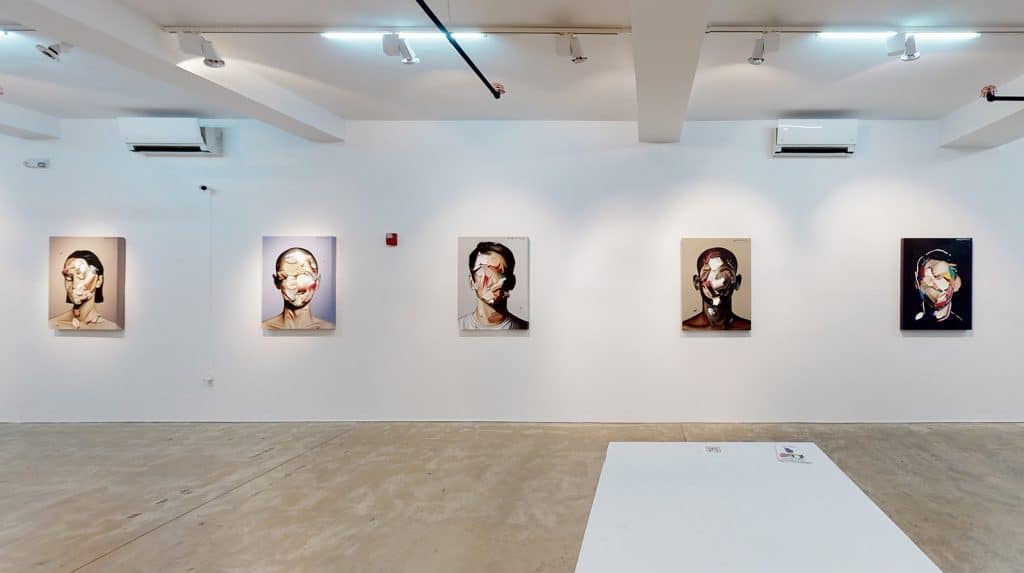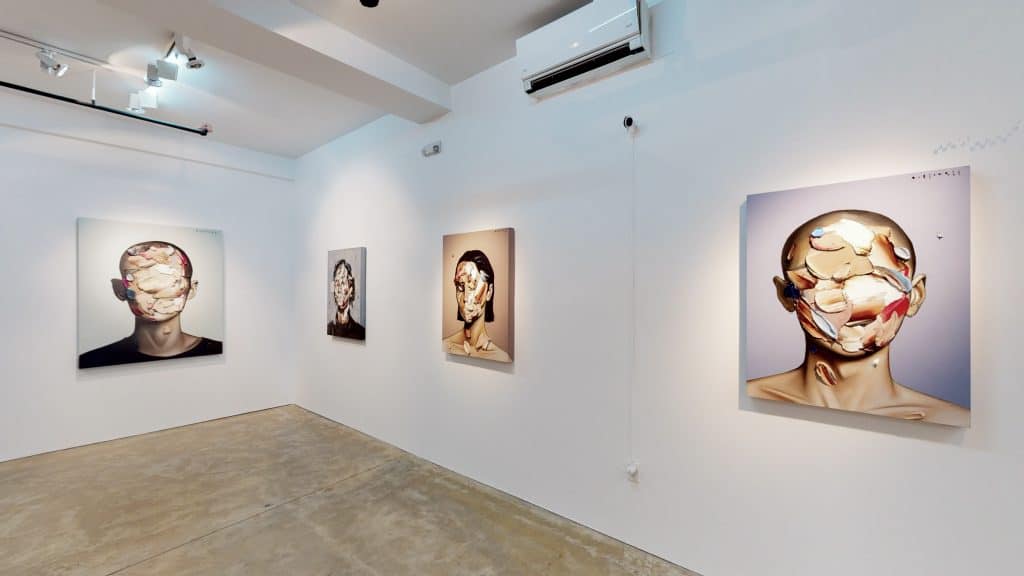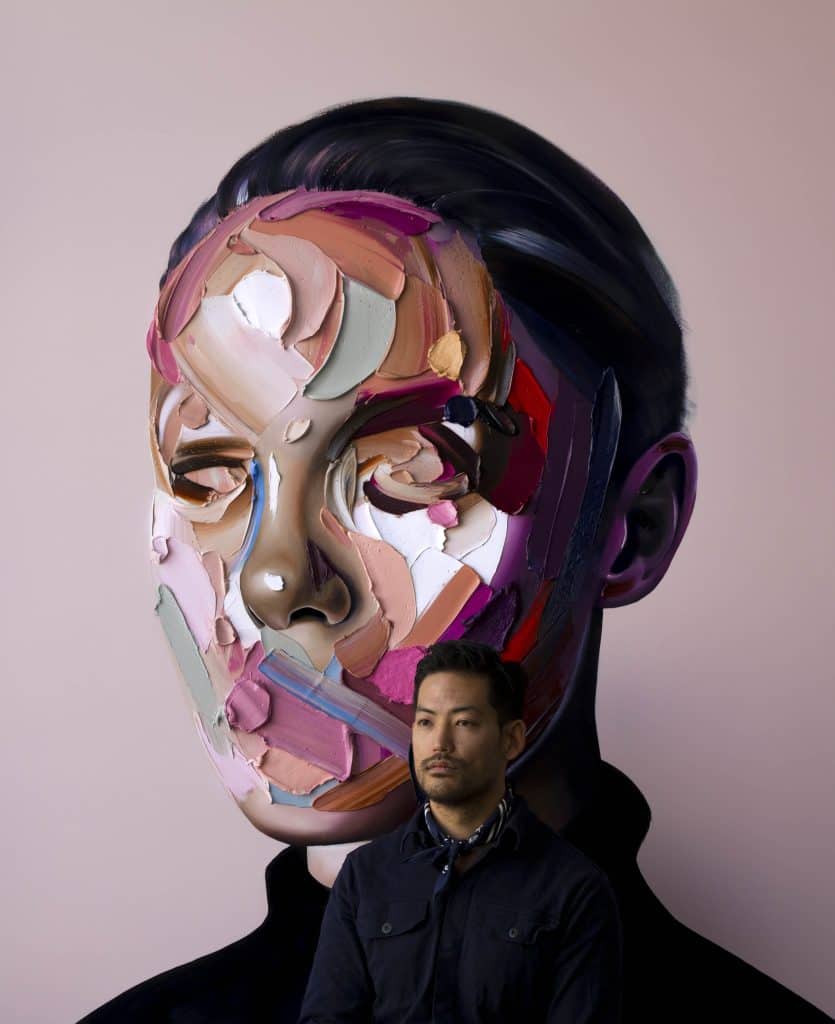Interviews
The Abstract Portraits of Joseph Lee – Interview with the Artist

By Shira Wolfe
“The work started to parallel how I was internalising myself and my own identity, that I didn’t know myself anymore. I started to strip away features, and things became more abstracted.”
Joseph Lee
GR gallery in New York City is currently hosting the solo exhibition “Passive. Aggression” by actor and self-taught visual artist Joseph Lee. Lee studies faces and the emotions behind them, creating portraits in his signature style by covering up the features with thick, colorful brushstrokes.
In Conversation with Joseph Lee
We spoke with the Los Angeles-based artist about his new paintings for the exhibition, created between 2020-2022, about the balance between acting and painting, and processing identity crisis and emotional blockades through art.
Shira Wolfe – Congratulations on your solo show at GR Gallery in New York. How was the opening?
Joseph Lee – It was fantastic. It’s been my first exhibition in three years. I think for a lot of artists the pandemic was very positive in the way that we could work unbothered, and there was interest from collectors, but it was also bittersweet because a lot of the paintings that go directly to the collectors won’t be seen by anyone else. So the past couple of years I decided to save my work and wait till I had a proper collection of work that I could showcase to people.
SW – It’s great you finally got to show your works to the public in this exhibition.
JL – Yeah, and specifically with my work, you can’t really justify it through a photo. Because there’s so much texture and depth to it, it’s something that I always want people to see in person.
SW – Can you tell me about your process? Your approach is very specific, with mostly large-scale portraits with this very thick texture of oil paint covering the features of the faces. Did you ever paint people’s faces in the beginning?
JL – Well, I’m not formally trained, so when I first started painting I just wanted to practice technical skills. I would take references from wherever I could find and apply them on the canvas as realistically in form as possible. Eventually, that evolved into me doing my own take.
A lot of that was informed by an experience I had in Korea. I’m an actor, and I was filming in Korea about 3-4 years ago. I grew up in Indiana, and I didn’t really grow up around many people that looked like me, there wasn’t a large Korean community. So I always had this romantic idea of wanting to go back to Korea where my parents are from, and to be able to experience and learn about their culture. And when I was able to finally do that, I faced a hard reality in that I still felt different, because I may look the same as the people around me, but my entire background and identity is American. I was 29 or 30 years old at the time, and I had this identity crisis: I felt my identity was split into being an American and a Korean and didn’t feel stable in either side of my identity.
And through that experience, my realistic work and portraits started becoming a lot more abstract. The work started to parallel how I was internalizing myself and my own identity, that I didn’t know myself anymore. I started to strip away features, and things became more abstracted.
SW – And how does your work as an actor influence your work as a visual artist?
JL – Because I wasn’t formally trained, I didn’t come in with this well of conceptual ideas or any type of philosophy. I needed to paint and draw what was nearest to me. And a lot of that comes from my acting experience, where the training involves observing other characters, noticing certain tendencies in their reactions and their behavior and their face.
When I think about it from a humanistic standpoint, I don’t see my acting and my art as being aligned, it’s more so that they are a balancing act for me psychologically. The acting side is very collaborative, it’s humbling in many ways because you realize you can’t make anything by yourself, you need to be part of a team. When I’m painting, I’m completely on my own, I don’t feel like I have to suppress my feelings, my emotions, my creativity, for anything other than myself. I am my own boss, I’m on my own time; I do whatever I want. It’s the humility of acting balanced with the selfishness and narcissism of art, I need those to be in a whole for me to function.
“I think I find that humility in doing portraits, because people alone are so fascinating, there are a million different stories, no one person is the same. I just find people so beautifully complex.”
Joseph Lee
SW – What really spoke to me in the exhibition text of “Passive. Aggression” was how in this period of the pandemic you felt an inability to verbally communicate emotions, which made you unrecognizable to yourself and others around you. Could you elaborate on that experience a bit, and how you worked through that with art?
JL – Growing up not only as a male in our society, but also as a Korean-American male, there are a lot of factors that we’ve defined as a society and culture that don’t allow us to be vulnerable and to fully express ourselves in that vulnerability. I think the pandemic was the perfect time for all those emotions and toxicities to come to the surface. In my daily life, I can distract myself very easily. I grew up as an only child, so I’m always used to just finding something to do. And when the pandemic happened, for many of us, it was the first time that everything just slowed down and stopped. All the little things that I kept myself distracted with were gone, and I had to sit with myself and actually deal with a lot of traumas and emotions that I would usually try to cover up to get along with my day.
I specifically found in myself this inability to address my emotions, sit with it comfortably, and to be able to communicate this. This brought me a lot of exhaustion and turmoil, and my wife recommended that I try therapy for the first time. It was probably the greatest gift I’ve ever had in my life. For the first time, I was learning to identify the root of a lot of who I am today. If my wife and I got into an argument, I used to immediately go into the studio and paint, instead of sitting there and properly communicating why I was feeling this way. And this was just a normalized behavior for me.
Through therapy, I realized I’m actually using my painting as a deflection at times, and as a crutch to really address what I’m going through. So that’s how the collection came to be – a lot of the paintings were produced as an immediate reaction, but also as a deflection of a lot of the emotions I was going through. And I titled it “Passive. Aggression” because there’s a sense of tension in each work that I’m not even fully aware of. It’s all there, but instead of openly telling you what the problems are, I’ll cover the works and the exhibition with a passively aggressive title.
SW – How do the different places where you’ve lived and worked influence your art?
JL – Because I come from a very rural country background, I always recognized that there was more out there in this world. I remember from an early age my favorite place was the library, and I would only look at travel books and books on world religions. I just recognized there was so much more out there for me to learn or experience. I think I find that humility in doing portraits because people alone are so fascinating, there are a million different stories – not one person is the same. I just find people so beautifully complex. That has always influenced my work and that will continue to influence my work.
SW – Are these portraits often of people you know or have met, or do they come from a more intuitive place?
JL – Both. My wife has been a muse of mine for a long time. Sometimes I take references from magazines or photos that I take. I’m always looking around for references. A lot of the portraits in this present show are instinctual, and there are a couple that are definitely referenced.

SW – Is there art hanging in your home, and if so, what?
JL – We have an original painting by my wife’s aunt that proudly hangs in our living room. Also, my grandfather’s calligraphy hangs in our bedroom. Two Cy Twombly prints in our dining room that my wife and I both gifted to each other by coincidence a couple of years ago.
SW – Is there a specific song, movie, work of art, or book that is significant to you in this period?
JL – These days I listen to a lot of hip-hop, and I love standup comedians, so I listen to a lot of podcasts with standup comedians. There’s a certain type of individualism and meritocracy in the standup comedy community that I find parallels to as an artist. I feel like being a standup comedian is a very dangerous job. It’s like you’re constantly tightrope walking. The idea of producing jokes and presenting them to an audience is so frightening to me, and I have so much respect for people who can go up there and be so vulnerable and let it all go. What I like about art is that, like with standup comedy, you get immediate feedback and reactions. I can tell when somebody likes a painting and when somebody doesn’t.
SW – Do you feel more of a pull to do more acting or painting at this point, or do you see yourself continuing to work in both fields?
JL – I’m definitely excited about both, and keeping the balance. When I was a kid, this was literally the dream, to be able to do two things that I love, that I don’t consider work. And I pray to the universe in gratitude every day that I’m able to do these things. From a realistic standpoint, the acting side is definitely less stable, and I think has less of a lifeline. So whatever work opportunities I’m able to get as an actor, I’m truly grateful for them, and I try to have the most fun with that I can, recognizing that it can all go away. The art side is something that I’m very stable with, it’s something I know I’ll do until I die, and it’s for me. So I hope that I can continue doing both as long as I can, but if not, you know, I’m an only child, so I’ll find something else to do!
SW – Are there any other new elements in your visual arts practice you would like to share, anything new you’re exploring in the upcoming period?
JL – I’ve been painting nonstop for the past few months so I think I’m going to go somewhere and disconnect from painting for a little bit. I want to finally get around to finishing those two books I started a year ago. Visit a few galleries and museums. Go somewhere with my camera. Painting is an overall manic process for me. So when I’m not in my studio, I’m doing everything else to catch up on life again. I’ll do my next exhibition in LA and Korea next year.
Relevant sources to learn more
Explore a selection of works for sale by Joseph Lee on Artland
Take a 3D tour of “Passive. Aggression” at GR Gallery
Read other artist interviews on Artland Magazine:
Jeffrey Gibson
Shirin Neshat
Kojo Marfo
Wondering where to start?



